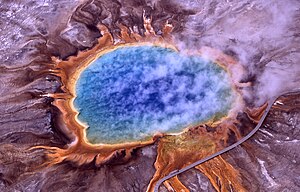Extremophile

An extremophile is an organism that thrives in and may even require physically or geochemically extreme conditions that are detrimental to the majority of life on Earth.
Most known extremophiles are microbes. The domain Archaea contains renowned examples, but extremophiles are present in numerous and diverse genetic lineages of both bacteria and archaeans. Furthermore, it is erroneous to use the term extremophile to encompass all archaeans, as some are mesophilic. Neither are all extremophiles unicellular; protostomes found in similar environments include the Pompeii worm, the psychrophilic Grylloblattodea (insects), Antarctic krill (a crustacean) and the water bear.
Types of extremophiles
There are many different classes of extremophiles, each corresponding to the way its environmental niche differs from mesophilic conditions. These classifications are not exclusive. Many extremophiles fall under multiple categories. For example, organisms living inside hot rocks deep under Earth's surface are both thermophilic and barophilic.
- Acidophile: An organism with an optimum pH level at or below pH 3.
- Alkaliphile: An organism with optimal growth at pH levels of 9 or above.
- Endolith: An organism that lives in microscopic spaces within rocks, such as pores between aggregate grains. These may also be called cryptoendoliths. This term also includes organisms populating fissures, aquifers, and faults filled with groundwater in the deep subsurface.
- Halophile: An organism requiring at least 2M of salt, NaCl, for growth.
- Hyperthermophile: An organism that can thrive at temperatures between 80-121 °C, such as those found in hydrothermal systems.
- Hypolith: An organism that lives inside rocks in cold deserts.
- Lithoautotroph: An organism (usually bacteria) whose sole source of carbon is carbon dioxide and exergonic inorganic oxidation (chemolithotrophs) such as Nitrosomonas europaea. These organisms are capable of deriving energy from reduced mineral compounds like pyrites, and are active in geochemical cycling and the weathering of parent bedrock to form soil.
- Metalotolerant: capable of tolerating high levels of dissolved heavy metals in solution, such as copper, cadmium, arsenic, and zinc. Examples include Ferroplasma sp. and Ralstonia metallidurans.
- Oligotroph: An organism capable of growth in nutritionally limited environments.
- Osmophile: An organism capable of growth in environments with a high sugar concentration.
- Piezophile: An organism that lives optimally at high hydrostatic pressure. Common in the deep terrestrial subsurface, as well as in oceanic trenches.
- Polyextremophile: An organism that qualifies as an extremophile under more than one category.
- Psychrophile/Cryophile: An organism that grows better at temperatures of 15 °C or lower. Common in cold soils, permafrost, polar ice, cold ocean water, and in/under alpine snowpack.
- Radioresistant: resistant to high levels of ionizing radiation, most commonly ultraviolet radiation but also includes organisms capable of resisting nuclear radiation.
- Thermophile: An organism that can thrive at temperatures between 60-80 °C.
- Xerophile: An organism that can grow in extremely dry, desiccating conditions. This type is exemplified by the soil microbes of the Atacama Desert.
Extremophiles and astrobiology
Astrobiology is the field concerned with forming theories, such as panspermia, about the distribution, nature, and future of life in the universe. In it, microbial ecologists, astronomers, planetary scientists, geochemists, philosophers, and explorers cooperate to constructively guide the search for life on other planets. Astrobiologists are particularly interested in studying extremophiles, as many organisms of this type are capable of surviving in environments similar to those known to exist on other planets. For example, Mars may have regions in its deep subsurface permafrost that could harbor endolith communities. The subsurface water ocean of Jupiter's moon Europa may harbor life, especially at hypothesized hydrothermal vents at the ocean floor.
External links
- Eukaryotes in extreme environments
- DaveDarling's Encyclopedia of Astrobiology, Astronomy, and Spaceflight
- The International Society for Extremophiles
References
- Rossi M; et al. (2003). "Extremophiles 2002". J Bacteriol. 185 (13): 3683–9. doi:10.1128/JB.185.13.3683-3689.2003. PMID 12813059.
{{cite journal}}: Explicit use of et al. in:|author=(help); Unknown parameter|month=ignored (help) - Satyanarayana, T. (2005). "Extremophilic microbes: Diversity and perspectives". Current Science. 89 (1): 78–90.
{{cite journal}}: Unknown parameter|coauthors=ignored (|author=suggested) (help); Unknown parameter|month=ignored (help)
